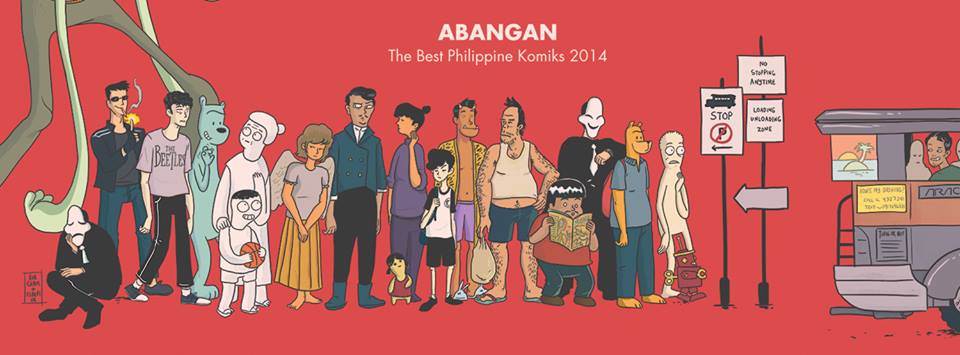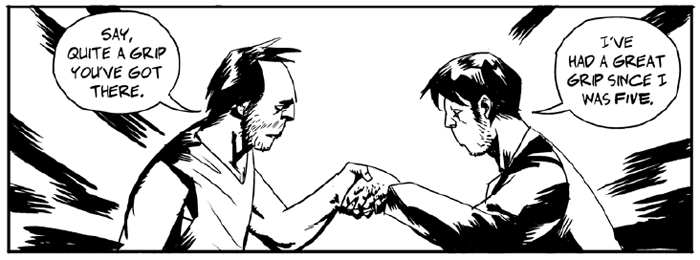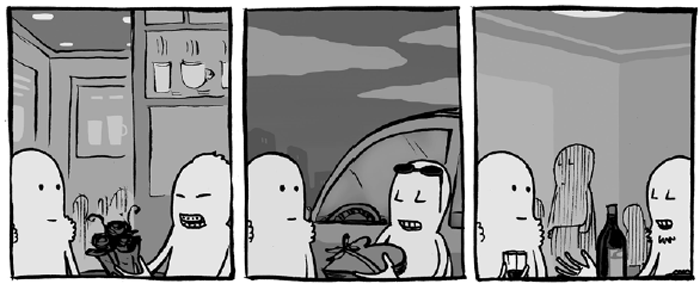RIDE ACROSS THE MANY WORLDS OF PHILIPPINE KOMIKS WITH ABANGAN
From heartbroken memoirs, to poetry comics, and yes, even superheroes, we can’t wait for Abangan: Best Philippine Komiks 2014.
originally published by Pacifiqa.com, April 2014

The editors of Abangan make the bold claim that their anthology represents The Best Philippine Komiks 2014. It’s a loaded statement, directed at two broad, overlapping audiences: Filipino readers (who don’t necessarily seek out local comics) and comic readers around the world (who might not be familiar with the work of Filipino creators). The editors – Rob Cham, Adam David, Carljoe Javier, and Elbert Or – have reasonable grounds to make that claim. Between them, they’ve created, edited, and taught about local comics with enough hands-on experience and formal savvy to possess a critical eye for the subject. And perhaps most importantly, they genuinely love comics – or “komiks”, as they opt to refer to the medium, locally. It’s a fact they declare in large, bold typeface at the start of their communal introduction. For the most part, their selection reflects this mix of critical curation and infectious enthusiasm for the medium.
Showcasing many worlds
The editors’ introduction also spells out quite explicitly how they intend audiences to read the collection –
“We wish the readers pay special attention to some of the more interesting landmarks of contemporary komiks, specifically the effort to experiment with formal and historical constraints inherent not only in comics as a form but in komiks as historical cultural production.”They go on to list a number of themes that recur in the komiks they’ve chosen, including the pervasive “kenkoy slapstick comedic aesthetic” and the transliteration of spandex-clad superheroics to a postcolonial Third World milieu, trusting the readers to figure out how these apply to the stories that follow.
There’s a deliberate push for diversity of styles, perhaps to offset the association of contemporary komiks with either traditional superhero fare or uninspired manga-fied fantasies. To that end, highlights from Emiliana Kampilan’s irreverent historical web comic Dead Balagtas share page space with Mica Agregado’s poetry comic “Blue Dust”. Likewise, Bong Redila’s whimsical, single-panel cartoons – which bring to mind old-timey children’s book illustrations by the likes of Windsor McKay – are represented alongside excerpts from Josel Nicolas’ gut-wrenching autobiographical comic Windmills V. It’s a deliberately pluralistic overview of the local komiks scene. Perhaps that might not be representative of the actual state of the medium, but it accounts for what the editors regard as its strongest work.
So that addresses editorial intent. But how do the actual komiks fare?

Playing with panels
For the most part, the comics live up to the editors’ framing. The collection opens with an excerpt from Manix Abrera’s wordless “Diwata”. It’s an ideal piece to train newbie komiks readers in the basics of visual storytelling. The uniform nine-panel grid layout, the use of panel borders to frame the narrative, and cartoonish character designs all work together to tell a straightforward vignette about romance, expectations, and music. It’s a fitting introduction to the fundamentals of sequential art.
It’s quickly followed up with an excerpt from Crime Fighting Call Center Agents by Noel Pascual. The title of the series itself is a playful misnomer, and this sample just adds to the confusion. But as a story fragment, in and of itself, it continues the “komiks 101” masterclass. It takes a very mundane situation – a chance introduction of two men by common friends – and quickly turns it into a most epic “handshake battle” across space and time. Without spoiling how the conflict unfolds, let’s just say that it provides Pascual ample opportunity to show off the kind of trippy, cosmic-level events that wouldn’t be out of place in an old Jim Starlin comic. Mindscrew doesn’t even begin to describe it. Once again, the panel borders and page layout go a long way towards getting the story across, this time emphasizing the massive scope of the ‘fight’ between these two very competitive hand-shakers.

Speaking in code
However, there’s more to komiks than just telling a story in pictures. Words are an inextricable part of the comic form, and it puts the issue of language front and center. Abangan is a polylingual anthology, so aside from the language of images, there’s a whole range of linguistic flavors, from street Tagalog to Filipinized English. By and large, the language choices feel appropriate.
The mock-pedagogical “Kung Bakit Lab Nating Mga Pinoy Ang Pagbibidyoke?” by the pseudonymous Dark Chapel uses casual Filipino to make its self-explanatory point. But its humor relies on so many culturally-specific references – from the Dutdutan tattoo festival, to Willie Revillame’s televised meltdown (“You don’t do that to me!”) – that its nuances would seem impenetrable even to somebody who might speak the language, but wasn’t well-versed in the details of Pinoy pop culture. To add to the confusion further, Dark Chapel throws in several gags that will only make sense to people who’ve watched World Wrestling Entertainment in the last few years. Otherwise, it all comes across like so much general absurdity. He may refer to the inclusive “natin”, but he seems to be addressing a much smaller in-group than the title suggests.
Crossing over
Chapel’s work seems even more limiting when compared to the excerpt from Paolo Fabregas’ Filipino Heroes League Volume 2, which follows it. It uses a college lecture as a framing device for a flashback to a superhero battle, set during the EDSA People Power revolt in 1986. The story plays around with multiple themes from the history of Western superhero comics and post-Martial Law Philippine politics.
On one hand, it deals with the issue of super-powered individuals taking part in a real-life political movement that became world-famous for mobilizing ordinary citizens in favor of popular democracy (well, in theory, anyway). And despite its brevity, the fictional lecture comes down squarely on the side of us ‘normal’ folk. This can be read as a sly commentary on the prominent role of real-world ‘superpowers’ – from the military, traditional politics, and across the seas – who were instrumental in the outcome of EDSA ’86. Of course, that presumes a familiarity with the events of EDSA, at all.
However, there’s also another layer to Fabregas’ story. The mid 1980s were also a tumultuous era for superhero comics, in general. DC studios’ Crisis on Infinite Earths storyline undid decades of continuity in their shared multiverse, while seminal works like Alan Moore’s Watchmen and Frank Miller’s The Dark Knight Returns problematized the role of superheroes, in terms of their effect real-world political affairs. (This also signaled a period of misguided darker and “edgier” superhero titles, which fell short of deconstructing superhero tropes with the same kind of nuance.) This is relatively common knowledge to people who are familiar with superhero comics, so it’s possible to read Fabregas’ work through that particular lens. When you tie both of these readings together, it drives home the themes emphasized by the editors in their introduction.
Filling the gaps
This is just a partial sliver of what Philippine komiks have to offer. Indeed, the editors themselves admit to certain limits – for example, the Manila-centric selection of creators, and the relatively lop-sided gender and sexuality ratio among them. While most of the stories merited inclusion here, a few of them could have been swapped out to address this matter, without compromising the overall quality of the anthology. In terms of style, the work of creators like FFY of EM Zine, Danielle Rina of UP Grail, and sample comics from Stache could have easily fit in here. But these exclusions just remind us of the broad scope of the local comics scene, as is.
On the whole, Abangan succeeds as a great snapshot of the possibilities of Philippine komiks. One might quibble about the label of “Best” – in terms of gut-level preferences and formal media critique. But it’s decidedly one of the most diverse collections of local work to date.
